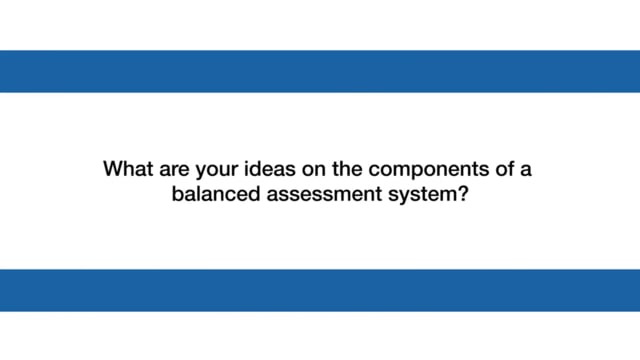What does balance mean in the context of assessment practice and assessment systems?
Assessment of learning and assessment for learning are ‘balanced’ in our practice and systems. All users of assessment information get the accurate information they need to make decisions and one group’s needs do not overshadow the needs of the other users of information (most importantly students). Assessment of learning should provide an accurate depiction of student achievement and be used to benefit students. Large-scale, summative assessments of learning should detect any improvements in the level or rate of student achievement.
These measures provide information once a year, or in the case of interim benchmarks two-three times per year they meet specific and limited purposes. They can reflect large-group increases or decreases in learning on an annual basis, and they tend to be used for high-stakes decisions.
Assessment for learning informs the moment-to-moment, daily and weekly instructional decisions students and their teachers make in order to support and advance learning.

A Learning Moment Video
Susan Brookhart explains what is meant by a balanced assessment system.
We’ve assembled more resources for this topic below.
ABCA Case Study—Mary Ruth Bird: Architect and Visionary for District-wide Assessment Literacy
This case study illustrates how participation in the Michigan Assessment Consortium’s Achieving Better Classroom Assessment (ABCA) helped one administrator define a strategy and create an outline for a three-year plan to build knowledge and understanding of three linked concepts: assessment literacy, a balanced assessment system, and formative assessment as a process. It also describes the detailed implementation plan that allowed her to embed this strategy into the work of the South Redford School District.
Assessment Crisis: The Absence of Assessment for Learning
This resource describes the impact of the absence of formative assessment in many classrooms.
Creating Effective Statewide Student Assessment Systems
This paper provides an overview of how effective state assessment systems can be created.
DASD Toolkit: The District Assessment Design Toolkit
The District Assessment Design Toolkit is a resource developed for local districts by the Center for Assessment. (Senior Associate, Joseph Martineau.) MAC has piloted the toolkit to support facilitation of use. Scroll down to DASD Toolkit on the NCEIA.org Resources page to access the toolkit
Developing Michigan Into a Top 10 Education Performing State Over the Next Ten Years
This paper describes MAC’s recommendations for the role of assessment to move Michigan into a Top 10 education performing state.
How can stealth assessment in games measure and support learning?
This Learning Point defines the concept of "stealth assessment" and describes how it can be used to embed ongoing formative assessment opportunities deeply into a game (or other engaging digital learning environment), blurring the distinction between learning and assessment.
How do authentic assessments deepen learning?
This Learning Point draws from cognitive science to describe how authentic assessments help students to embed their learning into long-term memory and why authentic assessments are meaningful to students.
MAC Reads! Book Study Process Guide: Revolutionize Assessment
The webinar articulates the if – then arguments that explain in lay terms the psychology of assessment for learning. The process guide supports group reading and study for the book Revolutionize Assessment.
The Role of Interim Assessments in a Comprehensive Assessment System
This paper describes how interim assessments can add value to a comprehensive assessment system.
Using Assessment Information to Make Sound Decisions (MAC videoconference– Carol Commodore)
This MAC produced video conference featuring Carol Commodore, co-author of Balanced Assessment Systems, Leadership, Quality and the Role of Classroom Assessment highlights the seven actions needed to achieve a balanced district assessment system.
What are summative assessments?
This Learning Point describes some key characteristics of summative assessment and describes its role within a balanced assessment system.
What is summative assessment and how can it be used in the classroom?
Classroom-level summative assessments primarily serve the purposes of teachers, students, and families. This Learning Point describes various types of classroom assessment and the decisions they inform.
